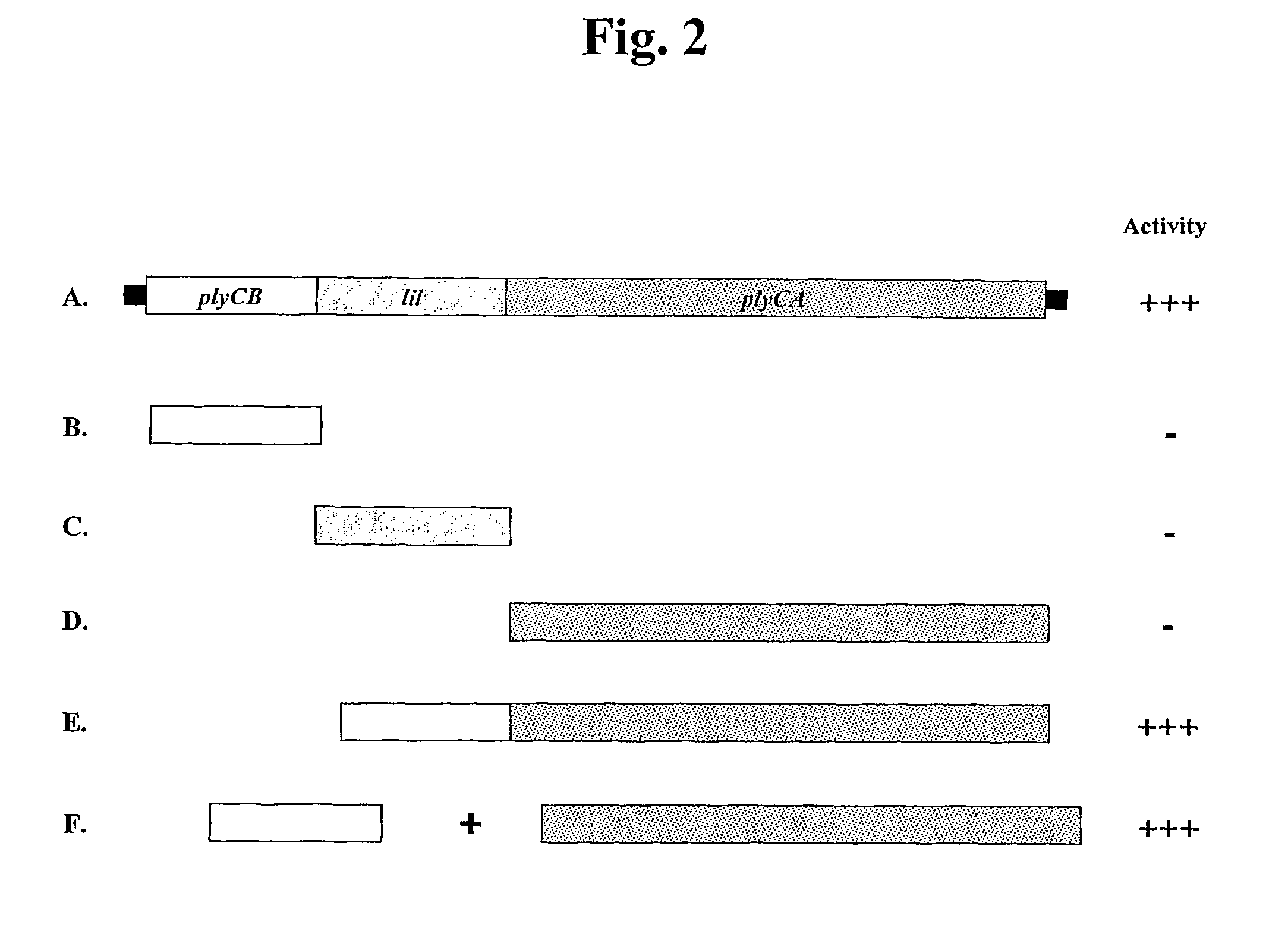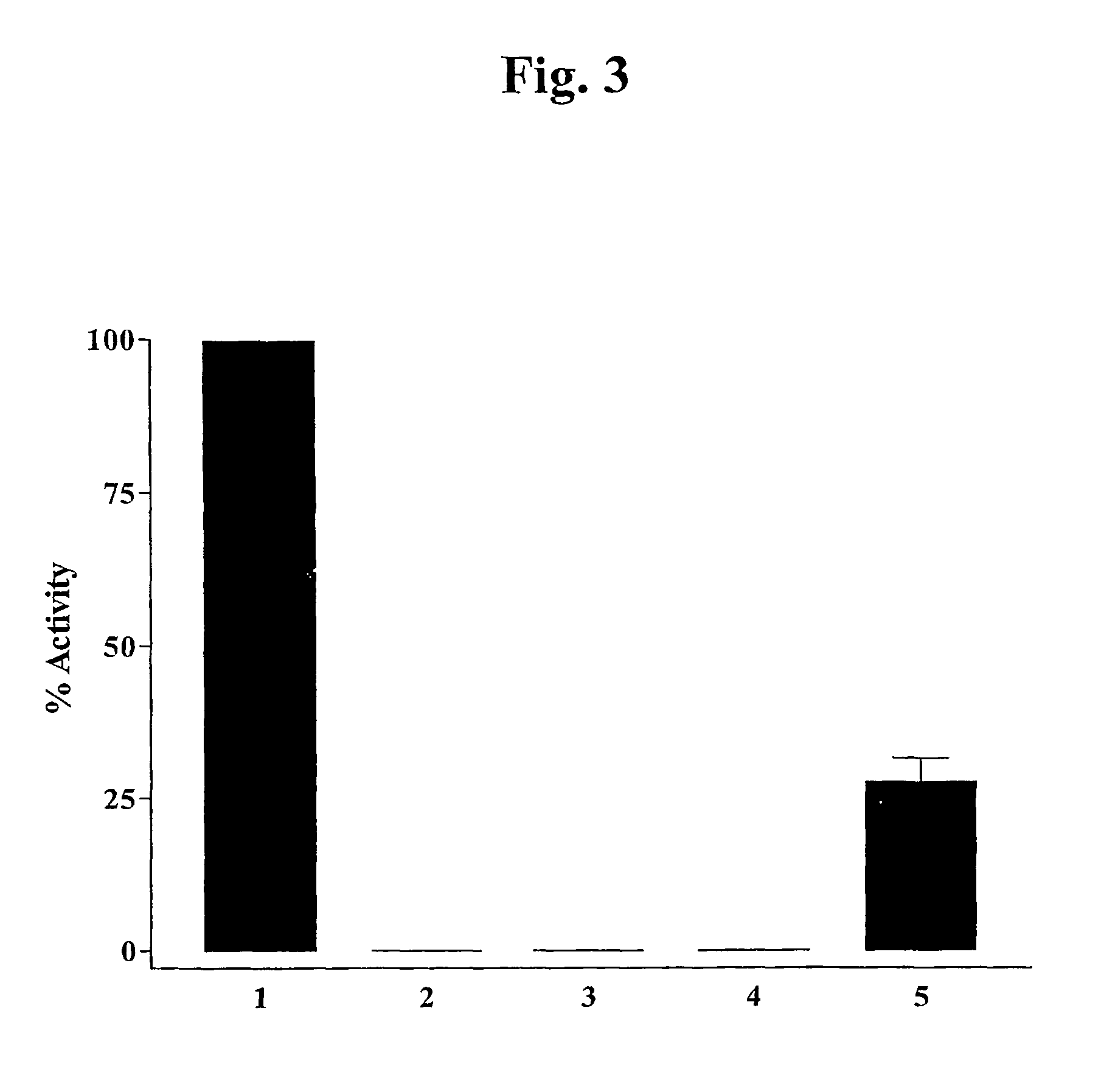Nucleic acids and polypeptides of C1 bacteriophage and uses thereof
a technology of csub>1 /sub>bacteriophage and polypeptides, which is applied in the direction of peptides, enzymology, and fused cells, can solve the problems of high strangle incidence, too impractical, complicated disease control, etc., and achieve the effect of avoiding possible contamination
- Summary
- Abstract
- Description
- Claims
- Application Information
AI Technical Summary
Benefits of technology
Problems solved by technology
Method used
Image
Examples
example 1
Determination of the Genomic Sequence of C1 Bacteriophage
[0103]Preparation and Purification of Phage
[0104]The lytic bacteriophage, C1, and its host bacteria, group C streptococcus 26RP66, are both part of The Rockefeller University collection. For preparation of the C1 bacteriophage, 26RP66 was grown at 37° C. in chemically defined media (CDM) for streptococci (JRH Biosciences) (27.13 g / L) and supplemented with 2.5 g / L sodium bicarbonate and 0.5 g / L cysteine. During early log phase (OD650˜0.25) 1 / 10 to 1 / 2 (v / v) of pre-warmed C1 phage was added and allowed to incubate until complete lysis occurred (approximately 40 minutes). The lysate was clarified by centrifugation (10,000×g, 10 min), passed through a 0.45-micron filter (Amicon) and final phage purification was achieved by ultracentrifugation (100,000×g, 2 hr) with the phage pellet resuspended in PBS and stored at 4° C.
[0105]Purification of Phage DNA
[0106]To purified phage particles, RNase and DNase (10 μg each) was added and allo...
example 2
Cloning of PlyC
[0142]Bacterial strains, phage, and growth conditions. Streptococcus pyogenes D471 (group A strep), Streptococcus equisimilis 26RP66 (group C strep), and the C1 bacteriophage are part of the Rockefeller University collection and were grown and maintained as previously described (Nelson, D., et al. (2001) Proc. Natl. Acad. Sci. U.S.A. 98:4107-4112; Nelson, D., et al. (2003) J. Bacteriol. 185:3325-3332). E. coli XL-1 Blue (Stratagene) and E. coli B834 (Novagen) were grown in Luria-Bertani (LB) broth at 37° C. in a shaking incubator (250 r.p.m.) unless otherwise stated. When needed, ampicillin (100 μg ml−1) or chloremphenical (34 μg ml−1) was added to the growth medium.
[0143]DNA manipulation. Phage DNA was isolated as previously described (Nelson, D., et al. (2003) J. Bacteriol. 185:3325-3332) and plasmid DNA was isolated using the Qiaprep kit (Qiagen). DNA polymerase, restriction, and modification enzymes were all purchased from New England Biolabs and used according to...
example 3
PlyC Activity Against Various Streptococcal Strains
[0160]Methods. Measurement of lysin activity was based upon turbidimetric determination of cell lysis. Simple detection of activity during purification utilized 96 well plates (Costar) and an automated plate reader (Molecular Devices) measuring a decrease in OD650 of group A streptococcus D471 cells. All bacterial strains were grown overnight in Todd Hewitt media, washed twice in phosphate buffered saline (PBS), and the OD650 was adjusted to ˜1.0 with PBS. Each cell suspension (225 μl) was added in triplicate to a 96 well microtiter plate just prior to addition of 250 U of purified PlyC (25 μl of a 10,000 U / ml stock). The OD650 was monitored for each well over the course of the experiment and the plates were shaken before each reading to maintain cell suspension. Controls with PBS were used for each strain to observe spontaneous lysis of cells and / or sedimentation effects that were not resolved by the shaking. Although no spontaneou...
PUM
| Property | Measurement | Unit |
|---|---|---|
| apparent molecular weight | aaaaa | aaaaa |
| OD | aaaaa | aaaaa |
| pH | aaaaa | aaaaa |
Abstract
Description
Claims
Application Information
 Login to view more
Login to view more - R&D Engineer
- R&D Manager
- IP Professional
- Industry Leading Data Capabilities
- Powerful AI technology
- Patent DNA Extraction
Browse by: Latest US Patents, China's latest patents, Technical Efficacy Thesaurus, Application Domain, Technology Topic.
© 2024 PatSnap. All rights reserved.Legal|Privacy policy|Modern Slavery Act Transparency Statement|Sitemap



